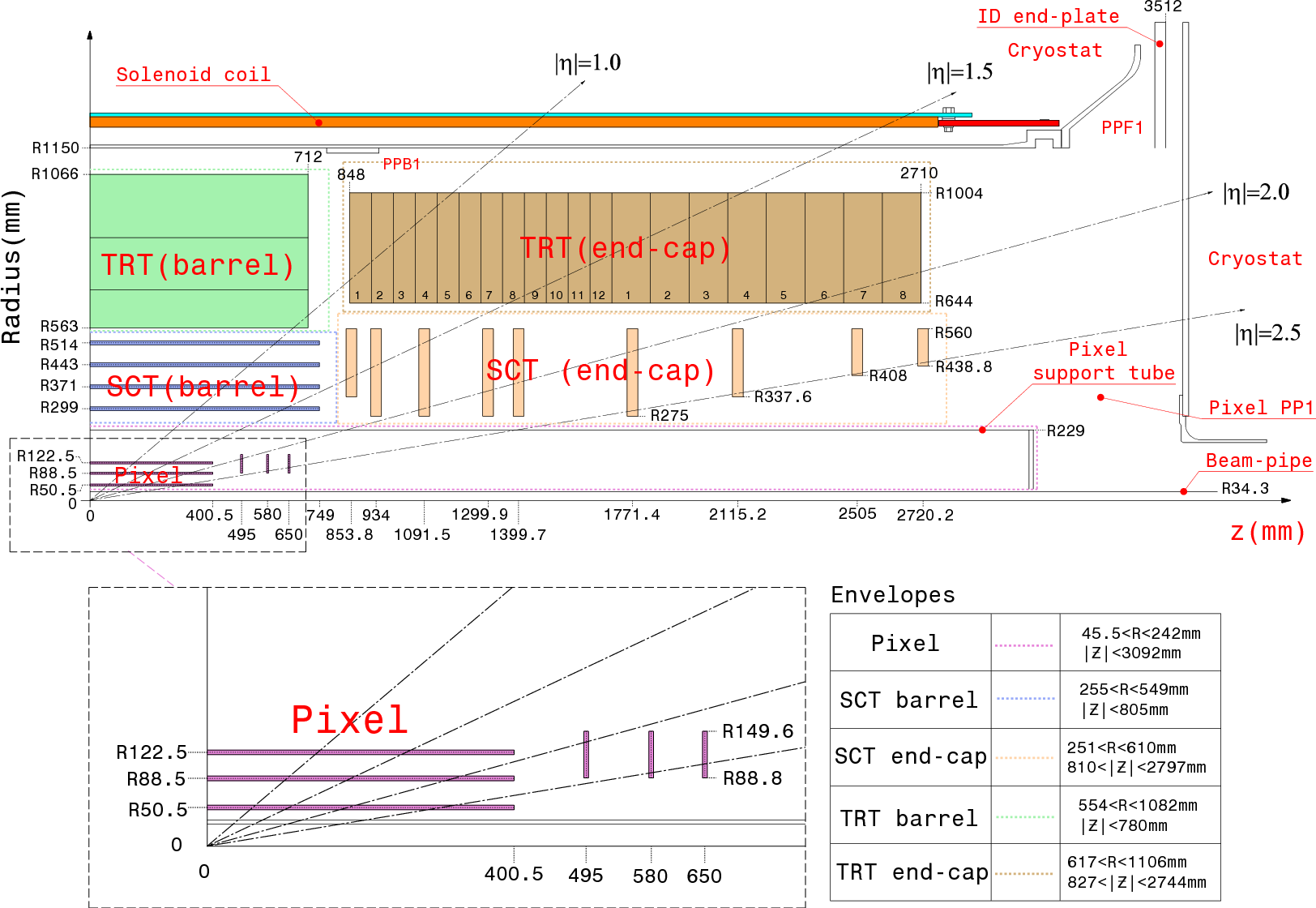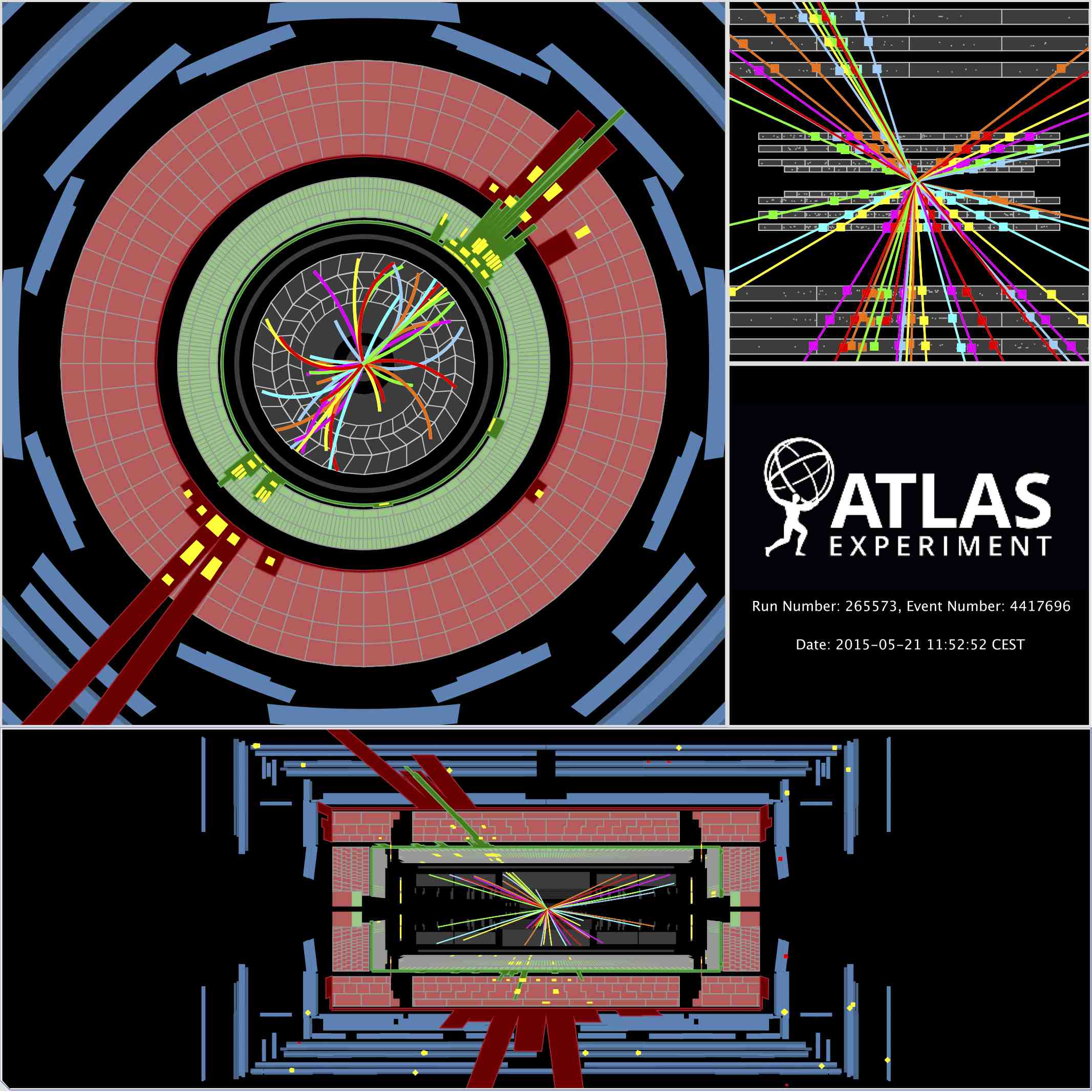Glossary
This is not intended to be an exhaustive glossary. You will find answers to many of your questions by using a search engine. However, here are a few ATLAS physics terms explained to start you off.
ATLAS coordinate system
The coordinate system of ATLAS is a right-handed coordinate system with the x-axis pointing towards the centre of the LHC tunnel, and the z-axis along the tunnel. The y-axis is slightly tilted with respect to vertical due to the general tilt of the tunnel.
Detector layout

The ATLAS detector has a layout that is typical for a collider detector and consists of two types of detector components:
- tracking detectors measure the position of a charged particle.
- calorimeters measure the energy of a particle.
Travelling from the collision point outwards there exist tracking detectors (inner detector), then calorimeters (electromagnetic and hadronic) and then more tracking detectors (muon spectrometer).
The complete ATLAS detector is split into a barrel part, where detector layers are positioned on cylindrical surfaces around the beam axis, and two end-cap parts, where detector layers are positioned in planes of constant z perpendicular to the beam pipe.
ATLAS coordinate system
The coordinate system of ATLAS is a right-handed coordinate system with the x-axis pointing towards the centre of the LHC tunnel, and the z-axis along the tunnel. The y-axis is slightly tilted with respect to vertical due to the general tilt of the tunnel.
Pseudorapidity
The pseudo rapidity (eta) describes the angle of a particle relative to the beam axis.

This diagram shows the cross-section of the inner detector layout through the beam axis.
The ATLAS detector design is symmetrical in pseudorapidity. The detector region |eta|>3 is particularly challenging since particle densities and energies are at their highest.
In hadron collider physics, particle production is normally constant as a function of pseudorapidity.
Azimuth angle
The azimuth angle (phi) is measured from the x-axis, around the beam. The ATLAS detector design is symmetrical in phi.
Monte-Carlo generators
Monte-Carlo generators are programs used for simulating data.
Event Display
Event displays are like snap-shots, tracing the paths of particles produced in a collision.

This event display shows three different views of the same proton collision. The three views help convey all the information about a three-dimensional event on a two-dimensional surface.
The top-left view shows a beams-eye view of the ATLAS detector. All of the information collected by the different detector systems is projected onto this cross-wise slice of the detector.
The top-right view shows the inner tracking detectors. Colored lines that radiate from the collision point show the passage of particles that registered in the tracking detectors.
The bottom view shows the ATLAS detector from the side. Onto this lengthwise slice of the ATLAS detector is projected all of the information collected by the different detector systems.
Tracks reconstructed from hits in the inner tracking detector are shown as arcs curving in the solenoidal magnetic field. The green, red and yellow bars indicate energy deposits in the liquid argon and scintillating-tile calorimeters, clustered in a structure typical of a di-jet event.
Finally, there is the date, time, run and event number displayed on every event display. This collision was recorded on 21 May 2015 11:52 am Central European Time (the time zone of the CERN laboratory in Geneva, Switzerland). Run and event numbers are used by physicists to catalog their data. Run numbers are unique. The first ATLAS run was recorded years before the LHC circulated its first beam, and run number will increase throughout the decades-long life of ATLAS. The event number resets to zero every time a new run starts.
Angular separation
The angular separation between physics objects e.g.lepton pair can be important in understanding or identifying different physics processes. It is calculated as a function of eta and phi.
Isolation can be required, meaning that there must be a minimum angular separation from any other significant object.
Good Run List
Good run lists are the way to select good data samples for physics analysis.
There are a number of ways the data may not be good e.g the LHC was not in stable-beam mode, the magnets were off, some of the sub-detectors were switched off. Only data that was collected during a good run is used for analysis in the ATLAS open data.
Jet
Jets are the dominant final state objects of high-energy proton-proton interactions at the LHC. They are key ingredients for many physics measurements and for searches for new phenomena. Jets are observed as groups of topologically-related energy deposits in the ATLAS calorimeters, most of which are associated with tracks of charged particles as measured in the inner detector. They are reconstructed and calibrated using a combination of methods based on simulation and data-driven techniques.
Good, bad and ugly jets
Jet cleaning criteria have been developed in order to identify fake jets which arise due to noise or to out-of-time energy depositions. Jets failing these criteria are flagged as either “bad”, likely to be fake, or “ugly”, likely to be mismeasured due to falling into less well instrumented regions.
In these analyses only events with good jets are considered.
Jet Vertex Fraction (JVF)
The Jet Vertex Fraction can be used to select jets with a high fraction of track energy originating from the selected primary vertex. It can be used to suppress pile-up jets.
Isolation
Isolation is important because it indicates where the lepton comes from. For example, an isolated electron is likely to originate from Z boson, W boson or tau. In contrast, a non-isolated electron is likely to originate from b-hadron or c-hadron decays.
Transverse momentum is the component of momentum perpendicular to the beam line.
In proton-proton collisions the overall momentum along the beamline is not known. This is because protons are composite particles consisting of many partons (quarks and gluons). When two protons collide it is actually the partons that interact.
Each of the partons carries an unknown fraction of the protons momentum. So their exact momentum along the beamline is unknown. We only know that the overall momentum perpendicular to the beamline is zero before the collision. Thus, transverse momentum is the most important momentum variable in a proton-proton collision.
Signal
High-energy physicists, whether making a precise measurement of a known quantity or searching for hypothetical new particles, select from the sample of events recorded those with characteristics resembling those of the desired signal, while rejecting as many non-signal events (background) as possible.
Background
Data contains both signal and background events. Background events are rejected so that the desired physics processes can be observed.
Fundamental Particles
Fundamental particles are the building blocks of matter as they are all indivisible. All other particles are therefore a combination of the fundamental particles.
Fundamental Forces
The fundamental forces, explain the interactions between particles in our universe. These forces are gravity, electromagnetism, the strong and the weak force. Electromagnetism and the weak force are linked through the electroweak theory.
Fermion
A subatomic particle, such as a nucleon, which has half-integral spin and follows a statistical description given by Fermi and Dirac.
Boson
A subatomic particle, such as a photon, which has zero or integral spin and follows a statistical description given by S.N. Bose and Einstein.
Channel
The decay channel signifies a certain route a physics process has taken.
For example, the W boson may decay to either a pair of hadrons or a pair of leptons. The signature for these W bosons in the detector are therefore either two hadrons or two leptons. These may be referred to the hadronic and leptonic channel of the W boson decay, respectively. If we want to study an object we cannot directly observe, e.g. a W boson, we must find a channel that is easily accessible.
In general, decays to leptons are easiest to spot but are not as abundant as hadronic decays.
Branching fraction
In general, a particle can decay in several modes or decay channels.
For example, a Z boson can decay into a pair of neutrinos, a pair of charged leptons, or a pair of quarks (i.e., all the standard model fermions lighter than half the Z mass). The probability for a Z to decay into a neutrino pair is about 20%, into a pair of charged leptons (electrons, muons, or taus) is about 10%, and into a pair of quarks (u,d,c,s,b) is about 70%. These probabilities are called branching fractions.
Electron Volt (eV)
One electron volt is equal to ~1.6 x 10^-19 joules. MeV (10^6) and TeV (10^12) are units of energy used in particle physics. 1 TeV is about the energy of motion of a flying mosquito.
Antiparticle
Antimatter: A particle and its antiparticle have the same mass as one another, but opposite electric charge and other quantum numbers. A collision between any particle and its antiparticle partner leads to their mutual annihilation, giving rise to various proportions of photons, neutrinos, and sometimes less massive particle–antiparticle pairs.